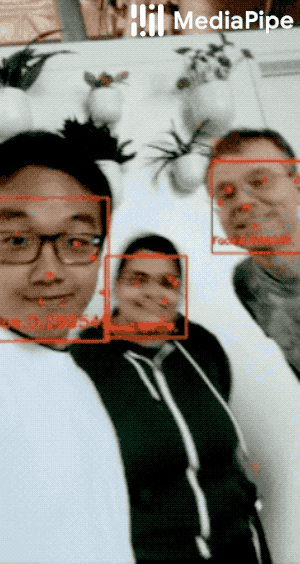1. 背景
AI 在视觉领域最常用的就是人脸检测、人脸识别、活体检测、人体与行为分析、图像识别、图像增强等,而且目前都是比较成熟的技术,不论商业化的 Paas 平台还是开源的模型,都几乎一抓一大把。一般的,AI 开发过程有以下几步:
特征分析
数据采集
数据标注
模型训练
模型推理
推理可以在云端也可以在客户端,端云各有各的场景,比如一般把人脸检测放到客户端,把人脸识别放到云端。本系列我们主要介绍视觉方向模型推理的工程实践。
2. 项目介绍
我们基于谷歌开源项目 mediapipe 提供的的模型,在客户端部署运行进行推理,mediapipe 提供了一下能力:
人脸检测(Face Detection)
三维人脸网络模型(Face Mesh)
虹膜检测(Iris)
手势(Hands)
姿态(Pose)
全身姿态(Holistic)
头发分隔(Hair Segmentation)
对象检测(Object Detection)
物体追踪(Box Tracking)
即时移动检测(Instant Motion Tracking)
Objectron
KNIFT
...
mediapipe 提供了bazel build -c opt --config=android_arm64 mediapipe/examples/android/src/java/com/google/mediapipe/apps/handtrackinggpu:handtrackinggpu编译出来即可运行。我们这里移动端开发框架我们基于开源项目https://github.com/terryky/android_tflite,该项目用来使用 Android NDK 运行和测量 TensorFlow Lite GPU Delegate 的性能。整体基于 NativeActivity 框架在进行摄像头采集后画面渲染和性能数据渲染。本文我们跑通实时人脸识别模型。移动端开发框架我们基于开源项目https://github.com/terryky/android_tflite,该项目用来使用 Android NDK 运行和测量 TensorFlow Lite GPU Delegate 的性能。整体基于 NativeActivity 框架在进行摄像头采集后画面渲染和性能数据渲染。本文我们跑通实时人脸识别模型。
3. 了解 NativeActivity
NativeActivity 是为单独使用 C|C++开发 app 提供的基类。纯 C++开发 Android 应用,最后还是需要一个 Java 层的壳子,在 Android 提供的开发框架中,已经使用 java 开发好了一个中间类,我们使用 C++开发的 Native 库之所以能运行,就是因为被这个中间类使用 JNI 的方式调用了,这个中间类就是 NativeActivity。这个 NativeActivity 类的核心功能,就是在特定事件发生时,调用我们使用 C++开发的 Native 库里的回调函数。比如在我们熟悉的生命周期函数 NativeActivity.onStart 中,调用 C++开发的 Native 库的 onStartNative 函数:
protected void onStart() { super.onStart(); onStartNative(mNativeHandle);}
复制代码
Native 层 Android 为我们提供了两个接口:
native_activity.h
android_native_app_glue.h
android_native_app_glue.h 封装了 native_activity.h,我们直接实现void android_main(struct android_app* state)方法即可。
NativeActivity 更多具体信息可以参考 Android 官方文档:GameActivity | Android 开发者 | Android Developers 。
4. 运行模型
我们选择的模型:https://storage.googleapis.com/mediapipe-assets/face_detection_short_range.tflite。运行模型一般我们有以下几个步骤:
加载模型;
摄像头预览纹理转换为 RGBA
将图像数据 feed 到模型引擎进行推理
解析渲染结果
4.1 加载模型
首先我们要将模型文件读取到内存,我们的模型文件放置在 Android 工程的 asset 路径下,将文件加载到内存std::vector<uint8_t> m_tflite_model_buf;:
boolasset_read_file (AAssetManager *assetMgr, char *fname, std::vector<uint8_t>&buf) { AAsset* assetDescriptor = AAssetManager_open(assetMgr, fname, AASSET_MODE_BUFFER); if (assetDescriptor == NULL) { return false; }
size_t fileLength = AAsset_getLength(assetDescriptor);
buf.resize(fileLength); int64_t readSize = AAsset_read(assetDescriptor, buf.data(), buf.size());
AAsset_close(assetDescriptor);
return (readSize == buf.size());}
asset_read_file (m_app->activity->assetManager, (char *)BLAZEFACE_MODEL_PATH, m_tflite_model_buf);
复制代码
tflite 提供了FlatBufferModel::BuildFromBuffer加载模型,返回tflite::FlatBufferModel类型的指针:
std::unique_ptr<tflite::FlatBufferModel> model = FlatBufferModel::BuildFromBuffer(model_buf, model_size)
复制代码
加载完模型,通过模型创建推理引擎解释器tflite::Interpreter,tflite 提供了InterpreterBuilder工具来构建tflite::Interpreter:
class InterpreterBuilder { public: InterpreterBuilder(const FlatBufferModel& model, const OpResolver& op_resolver);
复制代码
需要传入模型 model 及 OpResolver,OpResolver 是个抽象接口,返回给定操作码或自定义操作名的 tflite 注册器。这是将 flatbuffer 模型中引用的操作被映射到可执行函数指针(TfLiteRegistrations)的机制。InterpreterBuilder重载了括号操作符:
TfLiteStatus operator()(std::unique_ptr<Interpreter>* interpreter);TfLiteStatus operator()(std::unique_ptr<Interpreter>* interpreter, int num_threads);
复制代码
构建完InterpreterBuilder后创建tflite::Interpreter:
std::unique_ptr<tflite::FlatBufferModel> model;std::unique_ptr<tflite::Interpreter> interpreter;tflite::ops::builtin::BuiltinOpResolver resolver;InterpreterBuilder(*model, resolver)(&interpreter)
复制代码
InterpreterBuilder重载的括号操作符有两个,第二个有个线程数量的参数,我们也可以通过tflite::Interpreter的SetNumThreads手动设置:
int num_threads = std::thread::hardware_concurrency(); char *env_tflite_num_threads = getenv ("FORCE_TFLITE_NUM_THREADS"); if (env_tflite_num_threads) { num_threads = atoi (env_tflite_num_threads); DBG_LOGI ("@@@@@@ FORCE_TFLITE_NUM_THREADS=%d\n", num_threads); } DBG_LOG ("@@@@@@ TFLITE_NUM_THREADS=%d\n", num_threads); interpreter->SetNumThreads(num_threads);
复制代码
接下来分配 tensor 空间:
// Update allocations for all tensors. This will redim dependent tensors // using the input tensor dimensionality as given. This is relatively // expensive. This *must be* called after the interpreter has been created // and before running inference (and accessing tensor buffers), and *must be* // called again if (and only if) an input tensor is resized. Returns status of // success or failure. TfLiteStatus AllocateTensors();
复制代码
接下来解析引擎获取模型配置(主要是输入输出张量):
inttflite_get_tensor_by_name (std::unique_ptr<tflite::Interpreter> interpreter, int io, const char *name, tflite_tensor_t *ptensor){ memset (ptensor, 0, sizeof (*ptensor));
int tensor_idx; int io_idx = -1; int num_tensor = (io == 0) ? interpreter->inputs ().size() : interpreter->outputs().size();
for (int i = 0; i < num_tensor; i ++) { tensor_idx = (io == 0) ? interpreter->inputs ()[i] : interpreter->outputs()[i];
const char *tensor_name = interpreter->tensor(tensor_idx)->name; if (strcmp (tensor_name, name) == 0) { io_idx = i; break; } }
if (io_idx < 0) { DBG_LOGE ("can't find tensor: \"%s\"\n", name); return -1; }
void *ptr = NULL; TfLiteTensor *tensor = interpreter->tensor(tensor_idx); switch (tensor->type) { case kTfLiteUInt8: ptr = (io == 0) ? interpreter->typed_input_tensor <uint8_t>(io_idx) : interpreter->typed_output_tensor<uint8_t>(io_idx); break; case kTfLiteFloat32: ptr = (io == 0) ? interpreter->typed_input_tensor <float>(io_idx) : interpreter->typed_output_tensor<float>(io_idx); break; case kTfLiteInt64: ptr = (io == 0) ? interpreter->typed_input_tensor <int64_t>(io_idx) : interpreter->typed_output_tensor<int64_t>(io_idx); break; default: DBG_LOGE ("ERR: %s(%d)\n", __FILE__, __LINE__); return -1; }
ptensor->idx = tensor_idx; ptensor->io = io; ptensor->io_idx = io_idx; ptensor->type = tensor->type; ptensor->ptr = ptr; ptensor->quant_scale = tensor->params.scale; ptensor->quant_zerop = tensor->params.zero_point;
for (int i = 0; (i < 4) && (i < tensor->dims->size); i ++) { ptensor->dims[i] = tensor->dims->data[i]; }
return 0;}
static tflite_tensor_t s_detect_tensor_input;static tflite_tensor_t s_detect_tensor_scores;static tflite_tensor_t s_detect_tensor_bboxes;
tflite_get_tensor_by_name (&s_detect_interpreter, 0, "input", &s_detect_tensor_input);tflite_get_tensor_by_name (&s_detect_interpreter, 1, "regressors", &s_detect_tensor_bboxes);tflite_get_tensor_by_name (&s_detect_interpreter, 1, "classificators", &s_detect_tensor_scores);
复制代码
根据模型配置可以读取支持输入图片宽高:
int det_input_w = s_detect_tensor_input.dims[2];int det_input_h = s_detect_tensor_input.dims[1];
复制代码
4.2 摄像头预览纹理转换为 RGBA
将摄像头读取的纹理数据转换成 RGBA 模型才能识别,我们将纹理转换为内存数据:
unsigned char *buf_ui8 = NULL; static unsigned char *pui8 = NULL;
if (pui8 == NULL) pui8 = (unsigned char *)malloc(w * h * 4);
buf_ui8 = pui8;
draw_2d_texture_ex (srctex, 0, win_h - h, w, h, RENDER2D_FLIP_V);
glPixelStorei (GL_PACK_ALIGNMENT, 4); glReadPixels (0, 0, w, h, GL_RGBA, GL_UNSIGNED_BYTE, buf_ui8);
复制代码
需要想将摄像头读取的纹理绘制到帧缓存区,再通过 OpenGL 函数 glReadPixels 将纹理读取到内存缓存。
「注意:glReadPixels 是耗时操作」
4.3 将图像数据 feed 到模型引擎进行推理
先通过上面获取的引起输入张量 s_detect_tensor_input 获取引起分配的输入缓存:
void *get_blazeface_input_buf (int *w, int *h){ *w = s_detect_tensor_input.dims[2]; *h = s_detect_tensor_input.dims[1]; return s_detect_tensor_input.ptr;}
复制代码
将上面获取的图片内容转换成 float,赋给输入张量:
float mean = 128.0f; float std = 128.0f; for (y = 0; y < h; y ++) { for (x = 0; x < w; x ++) { int r = *buf_ui8 ++; int g = *buf_ui8 ++; int b = *buf_ui8 ++; buf_ui8 ++; /* skip alpha */ *buf_fp32 ++ = (float)(r - mean) / std; *buf_fp32 ++ = (float)(g - mean) / std; *buf_fp32 ++ = (float)(b - mean) / std; } }
复制代码
4.4 解析渲染结果
接下来调用解释器的Invoke()方法执行推理:
if (interpreter->Invoke() != kTfLiteOk) { DBG_LOGE ("ERR: %s(%d)\n", __FILE__, __LINE__); return -1; }
复制代码
接下来解析检测结果:
static intdecode_bounds (std::list<face_t> &face_list, float score_thresh, int input_img_w, int input_img_h){ face_t face_item; float *scores_ptr = (float *)s_detect_tensor_scores.ptr;
int i = 0; for (auto itr = s_anchors.begin(); itr != s_anchors.end(); i ++, itr ++) { fvec2 anchor = *itr; float score0 = scores_ptr[i]; float score = 1.0f / (1.0f + exp(-score0));
if (score > score_thresh) { float *p = get_bbox_ptr (i);
/* boundary box */ float sx = p[0]; float sy = p[1]; float w = p[2]; float h = p[3];
float cx = sx + anchor.x; float cy = sy + anchor.y;
cx /= (float)input_img_w; cy /= (float)input_img_h; w /= (float)input_img_w; h /= (float)input_img_h;
fvec2 topleft, btmright; topleft.x = cx - w * 0.5f; topleft.y = cy - h * 0.5f; btmright.x = cx + w * 0.5f; btmright.y = cy + h * 0.5f;
face_item.score = score; face_item.topleft = topleft; face_item.btmright = btmright;
/* landmark positions (6 keys) */ for (int j = 0; j < kFaceKeyNum; j ++) { float lx = p[4 + (2 * j) + 0]; float ly = p[4 + (2 * j) + 1]; lx += anchor.x; ly += anchor.y; lx /= (float)input_img_w; ly /= (float)input_img_h;
face_item.keys[j].x = lx; face_item.keys[j].y = ly; }
face_list.push_back (face_item); } } return 0;}
复制代码
face_t 封装了识别结果中的得分、左上、右下坐标:
typedef struct _face_t{ float score; fvec2 topleft; fvec2 btmright; fvec2 keys[kFaceKeyNum];} face_t;
复制代码
通过坐标我们可以在识别到的“人脸”上绘制一个框:
5. 总结
本文介绍了常见的 AI 开发步骤,以及常用的 AI 视觉应用。通过人脸检测功能,了解了 tensorflow lite 加载模型、输入数据、执行推理、获取结果等常用接口。













评论